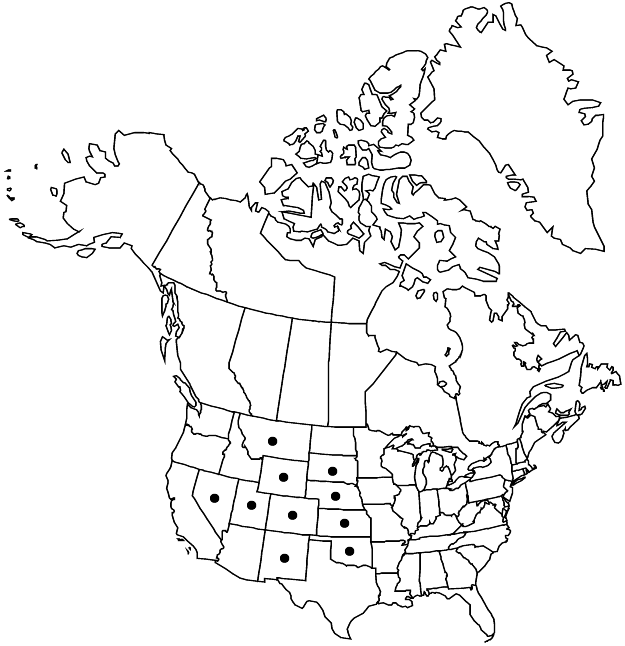Difference between revisions of "Eremogone hookeri"
Brittonia 33: 326. 1981.
FNA>Volume Importer |
imported>Volume Importer |
||
| Line 8: | Line 8: | ||
}} | }} | ||
|common_names=Hooker’s sandwort | |common_names=Hooker’s sandwort | ||
| + | |special_status={{Treatment/ID/Special_status | ||
| + | |code=F | ||
| + | |label=Illustrated | ||
| + | }}{{Treatment/ID/Special_status | ||
| + | |code=E | ||
| + | |label=Endemic | ||
| + | }} | ||
|basionyms={{Treatment/ID/Basionym | |basionyms={{Treatment/ID/Basionym | ||
|name=Arenaria hookeri | |name=Arenaria hookeri | ||
| Line 26: | Line 33: | ||
-->{{Treatment/Body | -->{{Treatment/Body | ||
| − | |distribution= | + | |distribution=Colo.;Kans.;Mont.;N.Mex.;Nebr.;Nev.;Okla.;S.Dak.;Utah;Wyo. |
|discussion=<p>Varieties 2 (2 in the flora).</p> | |discussion=<p>Varieties 2 (2 in the flora).</p> | ||
|tables= | |tables= | ||
| Line 56: | Line 63: | ||
|basionyms=Arenaria hookeri | |basionyms=Arenaria hookeri | ||
|family=Caryophyllaceae | |family=Caryophyllaceae | ||
| − | |distribution= | + | |distribution=Colo.;Kans.;Mont.;N.Mex.;Nebr.;Nev.;Okla.;S.Dak.;Utah;Wyo. |
|reference=None | |reference=None | ||
|publication title=Brittonia | |publication title=Brittonia | ||
|publication year=1981 | |publication year=1981 | ||
| − | |special status= | + | |special status=Illustrated;Endemic |
| − | |source xml=https:// | + | |source xml=https://bibilujan@bitbucket.org/aafc-mbb/fna-data-curation.git/src/bb6b7e3a7de7d3b7888a1ad48c7fd8f5c722d8d6/coarse_grained_fna_xml/V5/V5_138.xml |
|subfamily=Caryophyllaceae subfam. Alsinoideae | |subfamily=Caryophyllaceae subfam. Alsinoideae | ||
|genus=Eremogone | |genus=Eremogone | ||
Revision as of 00:31, 28 May 2020
Plants densely or loosely matted, green, not glaucous, somewhat woody at base. Stems erect, 1–15(–20) cm, scabrid-puberulent. Leaves: basal leaves persistent; cauline leaves in 1–4 pairs, usually little overlapping, often larger than basal leaves; basal blades straight to arcuate-spreading, subulate to needlelike, 0.3–4 cm × 0.5–1.5 mm, flexible or rigid, herbaceous, apex spinose, glabrous, often glaucous. Inflorescences 3–30+-flowered, congested, capitate or subcapitate cymes. Pedicels 0.2–2 mm, scabrid-puberulent. Flowers: sepals 1–3-veined, often obscurely so, linear-lanceolate to lanceolate, (5–)6–10 mm, not enlarging in fruit, margins narrow, apex narrowly acute or acuminate, glabrous or pubescent; petals white, oblanceolate, 4.5–8.5 mm, ± equaling sepals, apex rounded to obtuse; nectaries as lateral and abaxial mounds with transverse groove at base of filaments opposite sepals, 0.2–0.3 mm. Capsules to 4 mm, glabrous. Seeds black, ellipsoid-oblong to pyriform with hilar notch, 1.8–2 mm, tuberculate; tubercles rounded, elongate.
Distribution

Colo., Kans., Mont., N.Mex., Nebr., Nev., Okla., S.Dak., Utah, Wyo.
Discussion
Varieties 2 (2 in the flora).
Selected References
None.
Key
| 1 | Basal leaf blades 0.3-1.5 cm, straight or recurved, rigid; sepals 5-8(-9) mm | Eremogone hookeri var. hookeri |
| 1 | Basal leaf blades 2-4 cm, straight, rigid or flexible; sepals (7-)8-10 mm | Eremogone hookeri var. pinetorum |